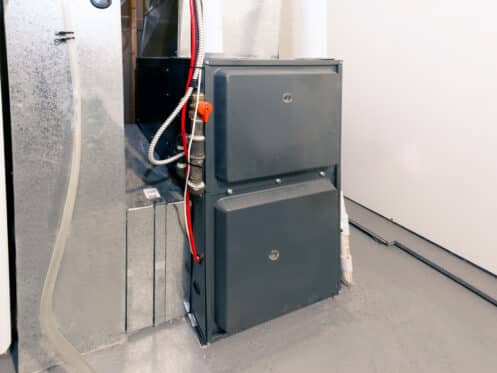As the cool weather of fall comes, it’s time to prepare your home for winter. A critical part of this preparation is checking your oil furnace to ensure it is ready to keep you warm. Below are seven essential steps that need to be taken care of during oil furnace maintenance by professionals.
1. Inspecting the Oil Tank
An oil tank stores and supplies the fuel for your furnace to supply heat during the colder months. The inspection process is methodical and meticulous, starting with a comprehensive visual examination of the tank’s exterior. A HVAC technician will look for telltale signs of wear and tear, such as visible corrosion, warping, or oil streaks suggestive of leakage. They will also check fuel lines and connections to make sure they do not have any leaks, rust, or defects to ensure the safe delivery of fuel to the furnace.
Overlooking the health of an oil tank can precipitate a domino effect of severe consequences. A compromised oil tank can lead to oil leaks, posing a severe environmental hazard and necessitating costly remediation procedures. Worse yet, an inconsistent oil supply due to a damaged tank or its piping can lead to sporadic heating or even a total shutdown.
2. Replacing Filters
Filters ensure that the air circulating through the furnace and your home remains clean and free of particulates. Filtration is essential for maintaining a healthy indoor environment and the efficient functioning of your furnace. However, these filters can become clogged with dirt, dust, and other airborne particles. When this happens, the furnace must work harder to push air through the clogged filters, leading to decreased efficiency and increased wear on the furnace components.
What’s more, neglecting filter maintenance can compromise the air quality in your home, exacerbating allergies and other respiratory conditions. The frequency of filter replacement depends on various factors, such as how often the furnace runs and the type of filter your furnace uses. Generally speaking, most filters should be replaced every one to three months during the heating season. In addition, it is recommended that you inspect the filters once a month. This inspection will let you know if the filter needs to be changed and give you a sense of how often they need to be replaced moving forward.
If you are uncertain about how to replace your furnace filter, don’t hesitate to call a qualified technician. They can guide you through the process, help you determine the type of filter your furnace requires, and instruct you on how often you need to change your filter based on your specific circumstances.
3. Cleaning the Furnace Interior
Over time, your furnace accumulates a build-up of soot, dust, and other debris, particularly in high-activity components such as the blower assembly and burner. Dirt build-up can impede the functions of these components. Regular cleaning reduces wear and tear on the furnace’s parts, ensuring they function smoothly. Moreover, it minimizes the chances of overheating or the need for costly emergency repairs due to sudden component failure.
However, cleaning the furnace interior is not a task that homeowners should undertake lightly or without proper knowledge. The cleaning process involves dealing with complex components, including the heat exchanger, the burners, the blower motor, and other intricate parts that can be damaged if not handled correctly.
In addition, signs of excessive soot or rust during the cleaning process can indicate a deeper, underlying issue with the combustion process. This is a crucial red flag that professionals should address promptly to prevent potentially dangerous malfunctions or complete system failures.
4. Examining the Chimney and Ventilation System
The exhaust system and venting play a crucial role in safely expelling combustion byproducts from your furnace outside the home. Checking the chimney begins with a visual examination for obvious blockages and damage. Look out for signs like soot or dust build-up. However, some obstructions, especially those high up the chimney, may not be readily visible.
Moreover, removing obstructions can be challenging due to the chimney’s height and the technical expertise required. Most homeowners leave this task to the professionals. HVAC technicians have the necessary equipment and training to safely remove obstructions and thoroughly inspect and clean your furnace’s exhaust and ventilation system.
5. Evaluating the Thermostat
The thermostat is essentially the brain of your heating system. It measures the ambient temperature and regulates the furnace operation to maintain the desired comfort level in your home. If your thermostat is not reading the indoor temperature correctly, your home may become too hot or get too cold in the winter. You can test your thermostat by taping an accurate thermometer on the wall next to it. Wait about 20 minutes, then check to see if your thermostat and thermometer show the same temperature. If the readings are more than a few degrees apart, you may have to ask a HVAC professional to recalibrate your thermostat.
6. Lubricating Moving Parts
Lubricating moving parts within an oil furnace is a pivotal aspect of routine maintenance. Due to persistent friction, components such as motors are susceptible to wear and tear. Regular application of a suitable, high-temperature lubricant can mitigate this friction, enabling smoother operation and contributing to the longevity of these parts.
7. Checking the Furnace Safety Controls
A HVAC professional should perform this task because furnace safety controls play a crucial role in ensuring the well-being of your home and loved ones. They are a set of essential components integrated into heating systems to monitor, regulate, and shut down the furnace if any dangerous conditions arise.
Pressure switches are responsible for monitoring the airflow within the furnace. They maintain proper ventilation, preventing the accumulation of harmful gases like carbon monoxide. On the other hand, flame sensors are designed to detect the presence of a pilot flame when the burner ignites. If the sensor does not detect a flame, it signals the furnace’s control board to shut down the fuel supply, preventing potential fire hazards. Finally, limit switches are one of the primary safety controls in a furnace. They monitor the temperature of the heat exchanger and prevent it from reaching dangerous levels. If the heat exchanger gets too hot, the limit switch will shut down the burner to avoid overheating, which could lead to cracks or damage.
HVAC professionals will inspect and test these controls during routine maintenance visits to ensure they function correctly. They will also check the emergency shut-off switch, which is a manual safety control accessible to homeowners. If you are not familiar with this switch, you should ask the technician to show you where it is during their visit in case a serious problem arises.
Schedule an Oil Furnace Maintenance Today
At Affordable Air & Heating, we have served the residents of Santa Clarita, CA since 1996. We install, maintain and repair heating and cooling systems. In addition, we are indoor air quality experts and install dehumidifiers, humidifiers, and air purifiers. Contact Affordable Air & Heating to schedule your oil furnace maintenance today.



